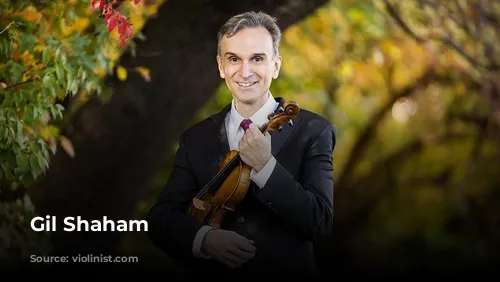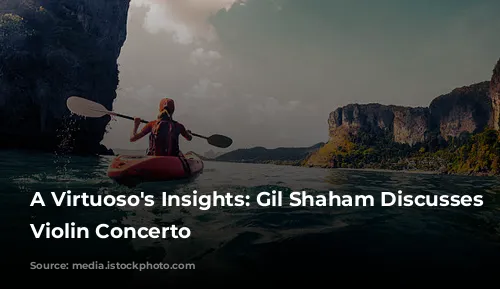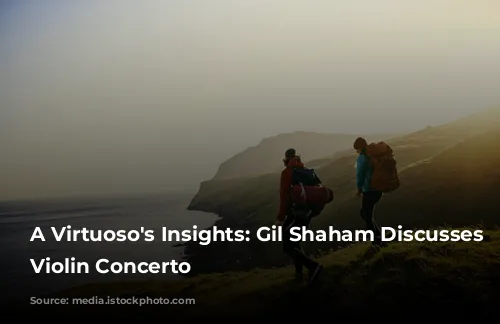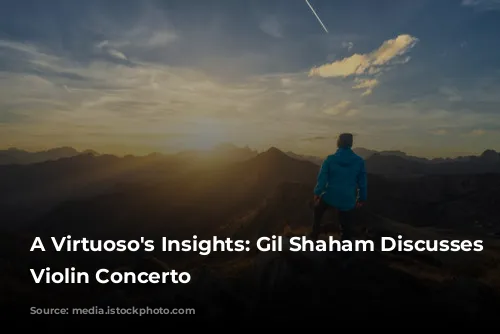Gil Shaham, one of the world’s most celebrated violin virtuosos, is not only a brilliant performer but also a fascinating commentator on music. His insightful thoughts were evident in our 2020 pandemic project, Gilharmonic, a series of engaging episodes featuring mini-master classes, interviews, and lively musical discussions.
A Deeper Dive into Dvorak
I recently had the pleasure of talking to Gil about his upcoming performance of Antonin Dvorak’s Violin Concerto in A minor with the Los Angeles Chamber Orchestra. The concert, scheduled for Sunday, December 11th at the Ambassador Auditorium in Pasadena, promises to be a captivating experience. But before the performance, Gil will be sharing his expertise at a master class held at the Colburn School on Saturday, December 10th.
When asked about the Dvorak Violin Concerto, Gil revealed that it often takes a back seat to Dvorak’s Cello Concerto. “It sort of lives in the shadow of the cello concerto,” he shared, “and maybe a little bit unfairly.” But what makes these concertos so different, beyond the obvious difference in instruments? “I feel like the cello concerto’s language is the very ‘American’ Dvorak,” Gil explained, “and the violin concerto is very much the ‘Czech’ Dvorak.”
A Blend of Cultures
Dvorak, a renowned 19th-century composer hailing from Bohemia (now the Czech Republic), spent a significant portion of his career in the United States. From 1892 to 1895, he served as the director of the National Conservatory of Music of America in New York City. This American experience had a profound influence on Dvorak’s music, as evidenced by his Symphony No. 9 (The New World Symphony) and other works composed during that time.
Although the Violin Concerto was composed before Dvorak’s American sojourn, his time in the United States certainly shaped his later works. The Cello Concerto and the “American” String Quartet in F, for example, were both written during his American period.
Unveiling the Old World Charm
“The violin concerto is equally masterfully written and equally as moving as the cello concerto,” Gil emphasized. “But it’s a little bit like the New World Symphony and the other symphonies by Dvorak – maybe Dvorak’s 7th Symphony isn’t played as much as the New World Symphony, but it’s one of the great, great masterpieces.”
So what makes the Violin Concerto sound more “Czech”? Gil attributes this to the concerto’s distinctly “Bohemian” elements: “There are turns of phrases throughout the first and second movements, I’m thinking of actual turns and trills, that sound very ‘Bohemian,'” he explained. “And the last movement is like a typical furiant and dumka, like something you would find in the Slavonic Dances. It’s a little bit in rondo form, the ‘furiant,’ and every time it comes back it’s a different setting, and surprising, and perfect, and propels the story forward. It’s the perfect cap on the piece.”
The second movement, in particular, captivated Gil: “It just breaks your heart, it’s so beautiful,” he said. “There is something about it that’s very bucolic, very beautiful.”
Gil’s admiration for Dvorak shines through in his words: “Dvorak is just the most amazing composer,” he said. “He was obviously fluent with violin writing. I recently played his Sonata, which I love to play. And I played the F minor trio, and the Romance – we really are very lucky with the repertoire he’s left for us. He was one of the great, great composers.”
An Artist on the Move
For his upcoming performance, Gil will be playing on the 1719 “Haupt” Strad, a prestigious instrument on loan from Rare Violins of New York In Consortium. This past year has been particularly busy for Gil, with many postponed engagements from previous seasons coming to fruition: “For a few seasons many things got postponed – so they all ended up happening this year,” he shared. “It’s great, but it was maybe a little busier than what my ideal balance would be.”
Despite his hectic schedule, Gil and his wife, Adele Anthony, continue to nurture a small studio at Bard College Conservatory. Their collaborative approach to teaching includes sharing a studio and students: “We wanted to err on the side of not having too many students,” he said. “They’re so amazing, it’s incredible to be around them and learn from them.”
Gil’s dedication to music extends beyond performances and teaching. He has several recording projects in the works, including a recording of the Korngold Violin Concerto with David Robertson and the St. Louis Symphony, a Prokofiev album featuring three different Prokofiev performances, and a project dedicated to new works.
“I’ve been very lucky and honored over the years that some very brilliant composers wrote pieces for me,” Gil shared. “But we never got around to recording them.” These recordings include Scott Wheeler’s violin concerto, “Birds of America”; Avner Dorman’s violin concerto, “Nigunum”; and Bright Sheng’s violin concerto, “Let Fly.”
A Chance to Experience Gil’s Art
If you’re in the Los Angeles area and wish to experience Gil Shaham’s artistry firsthand, don’t miss his upcoming concert or master class:
Master Class with Gil Shaham: 11 a.m. on Saturday, December 10 at the Colburn School’s Thayer Hall in downtown Los Angeles. Tickets are free, but registration is required.
Gil Shaham Plays Dvorak with Los Angeles Chamber Orchestra: 7 p.m. Sunday, December 11 at the Ambassador Auditorium in Pasadena, Calif. Tickets can be purchased online.
Don’t miss this opportunity to witness the talent and insights of one of the world’s most esteemed violinists.








